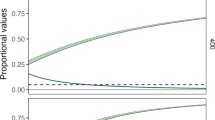Summary
A study of the sun leaves of two closed-forest (rainforest) and eight open-forest communities in subtropical southeast Queensland, Australia, showed that a large number of pioneer woody species in closed-forests had high levels of nitrate reductase (EC 1.6.6.1), whereas only a few herbaceous species in the open-forests showed high levels. There was a continuously declining gradient in nitrate reductase activity from pioneer to mature-forest species in all communities, associated with a decrease in Leaf Specific Area. The level of nitrate reductase activity was lower in certain plant families (including sclerophyllous monocotyledons, small-leaved composites and legumes), but still showed the same general relationship with Leaf Specific Area. The decrease in Leaf Specific Area is associated with an increase in both the dry weight: fresh weight ratio and the chlorophyll a: chlorophyll b ratio of the leaves. Three groups of plants can be recognised by nitrate reductase activity plotted against water content (% fresh weight) of their leaves-(1) pioneer, (2) mature-forest and (3) semi-sclerophyllous species. As the proportion of cytoplasm to structural tissue (indicated by water content) in leaves increases, there is a continuous increase in (a) nitrate reductase activity (b) total chlorophyll (per unit dry weight) (c) the proportion of chlorophyll b to chlorophyll a and (b) chloroplastic isoform of glutamine synthetase. These attributes are associated with high nitrogen content in the leaves and high photosynthetic potentials, resulting in rapid growth rates of pioneer species.
Similar content being viewed by others
References
Adams MA, Attiwill PM (1982) Nitrogen mineralization and nitrate reduction in forests. Soil Biol Biochem 14:197–202
Attiwill PM, Leeper GW (1987) Forest Soils and Nutrient Cycles, Melbourne University Press, Melbourne, pp 34–57
Field C, Mooney HA (1986) The photosynthesis-nitrogen relationship in wild plants. In: TJ Givnish (ed) On the Economy of Plant Form and Function. Cambridge University Press, Cambridge, pp 25–55
Field C, Merino J, Mooney HA (1983) Compromises between water-use efficiency and nitrogen-use efficiency in five species of California evergreens. Oecologia60:384–389
Gracia CA (1983) La Clorofila en los Encinares del Montseny. Ph.D. Thesis, University of Barcelona
Gracia CA (1988) Chlorophyll content and leaf energetics of plant communities in south eastern Queensland (Australia) in relation to water availability. In: F di Castri, C. Floret, S Rambal, J Roy (eds) Time Scales and Water Stress. Proceedings of the Fifth International Conference on Mediterranean Ecosystems International Union of Biological Sciences (IUBS), Paris, pp 87–93
Hegarty EE (1988) Canopy Dynamics of Lianes and Trees in Subtropical Rainforest. Ph.D. Thesis, University of Queensland
Jones JM, Richards BN (1977) Effect of reforestation on turnover of 15N-labelled nitrate and ammonium in relation to changes in soil microflora. Soil Biol Biochem 9:383–392
Lamb D (1980) Soil nitrogen mineralisation in a secondary rainforest succession. Oecologia 47:257–263
Medina E (1986) Forests, savannas and montane tropical environments. In: Baker NR, Long SP (eds) Photosynthesis in Contrasting Environments. Elsevier, Amsterdam, pp 139–171
Mooney HA, Ferrar PJ, Slatyer RO (1978) Photosynthetic capacity and carbon allocation patterns in diverse growth forms of Eucalyptus. Oecologia 36:103–111
Specht RL, Rundel PW (1990) Sclerophylly and foliar nutrient status of mediterranean-climate plant communities in southern Australia. Aust J Bot 38 (in press)
Specht RL, Specht A (1989) Canopy structure in Eucalyptus-dominated communities in Australia along climatic gradients. Oecol Plant 10:191–213
Specht RL, Clifford HT, Arianoutsou M, Bird LH, Bolton MP, Forster PI, Grundy R, Hegarty EE, Specht A (1990) Structure, floristics and species richness of plant communities in southeast Queensland. Proc R Soc Qd 100 (in press)
Stewart GR, Lee JA, Orebamjo TO (1972) Nitrogen metabolism of halophytes. I. Nitrate reductase activity in Suaeda maritima. New Phytol 71:263–267
Stewart GR, Popp M, Holzapfel I, Stewart JA, Dickie-Eskew A (1986) Localisation of nitrate reduction in ferns and its relationship to environment and physiological characteristics. New Phytol 104:373–384
Stewart GR, Hegarty EE, Specht RL (1988) Inorganic nitrogen assimilation in plants of Australian rainforest communities. Physiol Plant74:26–33
Vitousek PM (1981) Clear-cutting and the nitrogen cycle. In: FE Clark and T Rosswall (eds) Terrestrial Nitrogen Cycles. Processes, Ecosystem Strategies and Management Impacts Ecol Bull (Stockholm) 33:631–642
Wiklander G (1981) Clear-cutting and the nitrogen cycle. Heterogeneous nitrogen leaching after clear-cutting. In: FE Clark and T Rosswall (eds) Terrestrial Nitrogen Cycles. Processes, Ecosystem Strategies and Management Impacts Ecol Bull (Stockholm) 33:642–647
Author information
Authors and Affiliations
Rights and permissions
About this article
Cite this article
Stewart, G.R., Gracia, C.A., Hegarty, E.E. et al. Nitrate reductase activity and chlorophyll content in sun leaves of subtropical Australian closed-forest (rainforest) and open-forest communities. Oecologia 82, 544–551 (1990). https://doi.org/10.1007/BF00319799
Received:
Accepted:
Issue Date:
DOI: https://doi.org/10.1007/BF00319799




